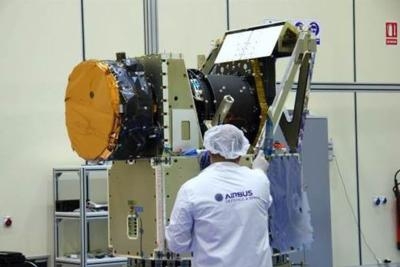Mon, Oct 19, 2015
Spacecraft Will Be The First European Exoplanet Tracker
Airbus Defense and Space has finished building the structural model for ESA’s CHEOPS (CHaracterising ExOPlanet Satellite), Europe’s first mission to search for exoplanetary transits by performing ultra-high precision photometry on bright stars already known to host planets.

Airbus Defense and Space, as prime contractor of CHEOPS, is preparing the first spacecraft test campaign in Spain. The structure of the platform has been fitted with mass dummies to represent the different equipment of the satellite, and the thermomechanical model of the instrument has also been integrated. The structural model will now undergo mechanical qualification through the end of the year. Once it is qualified, the structure will later be used as flight model.
The proposed design for CHEOPS is based on the AstroBus family of satellite platforms, and uses the AstroBus-S model. Other missions based on the AstroBus series include SPOT 6 and 7, KazEOSat-1, the Sentinel-5 Precursor, PeruSat-1 and the MetOp Second Generation satellites.
Work is progressing rapidly according to schedule and Airbus Defense and Space teams in Spain are working hard to meet the demanding deadline since CHEOPS is ESA’s first small-class mission, to be launch-ready in December 2017.
The satellite consists of a Ritchey-Chrétien telescope integrated in a standard small platform. Over three and a half years, from its dedicated low-Earth orbit, it will observe bright and nearby stars that are known to have a planetary system. One of the main objectives of CHEOPS is to determine the radii of planets with masses that are already known as a result of studies using ground-based observatories. This will then allow deductions to be made as to their size and density in order to classify them as rocky, gas or other types of planets.
CHEOPS was selected in October 2012 from among 26 scientific proposals and has an estimated cost of €50 million (approx. $57 million) for the complete mission.
(Image provided with Airbus news release)
More News
DETRESFA (Distress Phrase) The code word used to designate an emergency phase wherein there is reasonable certainty that an aircraft and its occupants are threatened by grave and i>[...]
"General aviation is at the forefront of developing and introducing innovative technologies that will transform the entire aviation industry..." Source: Kyle Martin, Vice President>[...]
Direct Straight line flight between two navigational aids, fixes, points, or any combination thereof. When used by pilots in describing off-airway routes, points defining direct ro>[...]
Aero Linx: Women in Corporate Aviation Women in Corporate Aviation support individuals seeking career advancement and professional development in the business aviation industry. Me>[...]
“We would like to thank the many volunteers that help throughout the year to pull off the event, as well as the several reviewers, judges, and SURVICE staff that provide team>[...]
 ANN's Daily Aero-Term (04.26.24): DETRESFA (Distress Phrase)
ANN's Daily Aero-Term (04.26.24): DETRESFA (Distress Phrase) Aero-News: Quote of the Day (04.26.24)
Aero-News: Quote of the Day (04.26.24) ANN's Daily Aero-Term (04.27.24): Direct
ANN's Daily Aero-Term (04.27.24): Direct ANN's Daily Aero-Linx (04.27.24)
ANN's Daily Aero-Linx (04.27.24) Aero-News: Quote of the Day (04.27.24)
Aero-News: Quote of the Day (04.27.24)



